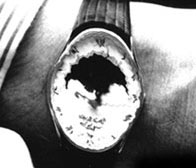Distorted Vision (Metamorphopsia)

- Visual illusion that objects appear warped because their borders are curved or bent
- When monocular, usually results from displacement of foveal cone photoreceptors by hemorrhage, edema, or scarring
- Major causes are age-related macular degeneration, central serous chorioretinopathy, epiretinal membrane formation, retinal detachment, ocular trauma or inflammation
- When binocular and persistent, consider abnormal processing in visual cortex in stroke or other lesions
- When binocular and transient, consider transient ischemic attack, migraine, or occipital seizure
- Viewed objects have curved borders
- In retinal lesions, viewed objects may appear relatively small ("micropsia") or large ("macropsia") in affected eye
- In visual cortex lesions, viewed objects may have grotesque distortions ("looks like a Picasso painting")
- New glasses that correct for previously uncorrected astigmatism can give a similar illusion
- Scotomas (blank or dark areas in field of vision) can make vision appear so disturbed that patients report it as distorted
- Persistent monocular visual distortion forces attention to retina
- Persistent or transient binocular visual distortion forces attention to brain
- Many retinal and brain causes are treatable and some require immediate intervention
- Outcomes vary depending on cause of this visual illusion
